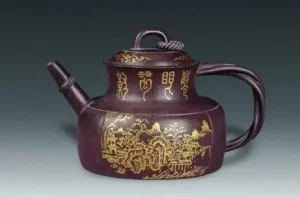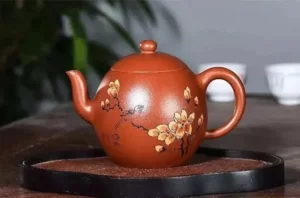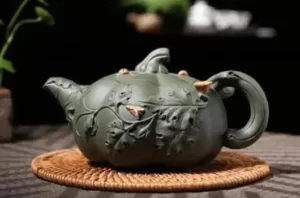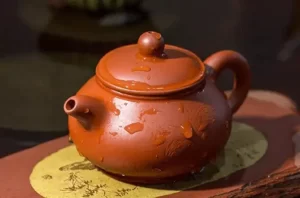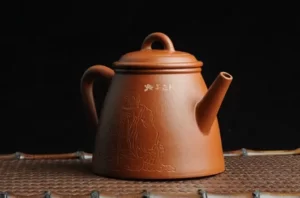Everything You Need to Know About Yixing Teapot
Yixing teapot is a traditional Chinese tea brewing vessel. It was born 600 years ago in the Ming Dynasty. Yixing teapot refers to the Zisha teapot made from the clay of Huanglong Mountain in Dingshu Town, Yixing, which is special and rare. Processed by masters, Yixing Zisha teapots have practical, artistic and collectible values.
This is a topic page about yixing zisha teapots. It is like a wikipedia for zisha teapots, containing many frequently asked questions about yixing clay teapots, with all the answers coming from old craftsmen of the Yixing century-old brand.
Yixing Teapot 101
We have spent 3 months to write this course for you.The course includes 9 articles and we will update and maintain them regularly.
- If you are new to yixing teapots, it will take you to the intermediate level.
- If you want to buy a real yixing teapot, it will avoid many pitfalls for you.
- If you already have some yixing zisha teapots, you will know how to appreciate them better after reading it.
Keep You Informed of the Latest Updates
Now, Do You Know How to Pick a Yixing Teapot?
Let’s take a look at these Yixing Teapots below. They are all handmade from clay that we have treasured for many years and very easily produce the luster of jade. If you want to customize the decoration, please feel free to contact us.
Guides (10 resources)
Frequently Asked Questions
Seasoning a Yixing teapot is an essential process that enhances the flavor and aroma of the tea brewed in it. Here are the steps to properly season a Yixing teapot:
Choose a tea: Select one type of tea or a group of similar teas to season the teapot. Common choices include oolong teas, pu-erh teas, or black teas. Avoid using flavored or scented teas, as they can leave strong aromas that might interfere with the natural seasoning process.
Rinse the teapot: Before the first use, rinse the teapot with hot water (without soap) to remove any dust or residues from the manufacturing process. This step is essential for preparing the teapot for seasoning.
Brew the tea: Add the chosen tea leaves to the teapot and brew the tea using water at the appropriate temperature for the specific type of tea.
Pour out the tea: After the tea is brewed, pour it out and avoid letting the tea leaves sit in the teapot for an extended period. Leaving the leaves in the teapot can lead to oversteeping and impact the seasoning process negatively.
Repeat the process: Continue brewing the same type of tea in the teapot over multiple sessions. Ideally, brew the same tea for several weeks or months to allow the Yixing clay to absorb and retain the tea’s flavor.
Air drying: After each use, rinse the teapot with hot water to clean it gently, and then allow it to air dry completely before storing it. Do not use soap or cleaning agents, as they can be absorbed by the clay and affect the tea’s taste.
Patience and dedication: Seasoning a Yixing teapot is a gradual process, and it requires patience and dedication. The longer and more frequently you use the teapot with the same type of tea, the more pronounced the seasoning will become.
Remember, the goal of seasoning is to create a unique and personalized teapot that enhances the flavor of the chosen tea. Avoid using the teapot for different types of tea, as it can lead to flavor contamination. Also, be sure to take good care of your Yixing teapot by following proper cleaning and storage practices to preserve its seasoning and prolong its lifespan.
It is not recommended to use soap or detergent when cleaning a Yixing purple clay pot, as it can absorb the residue and affect the pot’s flavor. Instead, rinse it with hot water and use a soft brush if necessary.
Choosing the right Yixing teapot for a specific type of tea involves considering several factors, such as the type of clay, shape, size, and personal preferences. Here are some guidelines to help you make the best choice:
Clay Type: Yixing teapots are available in different types of clay, each with its unique characteristics. The three primary types are:
Zisha (Purple Clay): Ideal for most types of teas, especially oolong, black, and pu-erh teas. Zisha clay has excellent heat retention and can enhance the tea’s flavor over time due to its porous nature.
Duan Ni: Suitable for high-fired oolong teas and black teas. Duan Ni clay is known for its lighter color and excellent heat retention, making it an excellent choice for these teas.
Hong Ni (Red Clay): Suitable for lighter teas like green and white teas. Hong Ni clay has a slightly higher iron content, which helps preserve the freshness of delicate teas.
Shape: The shape of the teapot can influence the brewing process and the tea’s taste. Consider the following shapes:
Round Teapots: Ideal for rolled and ball-shaped teas like oolongs, as the rounded shape allows the leaves to expand and unfurl properly during brewing.
Flat Teapots: Great for strip-style teas like black teas, as the flat shape allows the leaves to spread out more, promoting even extraction of flavors.
Size: Choose a teapot size that matches your typical tea-drinking habits. Larger teapots are suitable for serving multiple guests or brewing large quantities of tea. Smaller teapots are more suitable for personal use or when brewing specific premium teas.
Personal Preference: Ultimately, your personal preference plays a significant role in choosing the right teapot. Consider your favorite types of teas and how you prefer to brew and serve them.
Before making a decision, it’s a good idea to research and read reviews or seek advice from experienced tea enthusiasts or tea sellers who are familiar with Yixing teapots. Keep in mind that using a dedicated teapot for a specific type of tea over time can season the pot, enhancing the flavor and aroma of your brews.
Proper storage of your Yixing clay teapot is essential to maintain its quality and prolong its life. Follow these guidelines to ensure your teapot remains in good condition:
Clean and Dry Before Storage: After each use, rinse the teapot with hot water and allow it to dry completely. Do not use soap or detergent, as mentioned earlier, to avoid damaging the clay and affecting the tea flavor.
Air Drying: Allow the teapot to air dry naturally. Avoid using a towel to dry it, as the fibers from the towel might get stuck in the porous clay.
Store Without the Lid: When not in use, it is best to store the teapot without the lid on. This allows the inside of the teapot to breathe and prevents any potential moisture buildup.
Store in a Cool, Dry Place: Choose a cool and dry location for storage. Avoid direct sunlight, extreme temperatures, and humid environments, as they can affect the clay and lead to mold or mildew growth.
Avoid Strong Odors: Yixing clay has the unique property of absorbing and retaining the flavors and aromas of the teas brewed in it. To avoid mixing different tea flavors, do not store the teapot near strong-smelling substances or foods.
Avoid Stacking: If you have multiple Yixing teapots, it’s best not to stack them inside one another. Stacking can lead to scratches or damage to the teapot’s surface.
Use a Soft Cloth or Bag: You may consider wrapping the teapot in a soft cloth or storing it in a padded bag to protect it from accidental bumps or scratches.
Regular Inspection: Periodically check your teapot for any signs of mold, mildew, or damage. If you notice any issues, gently clean the teapot and allow it to dry thoroughly before returning it to storage.
By following these storage tips, you can preserve the integrity of your Yixing clay teapot and continue to enjoy its unique properties for brewing delicious teas. Remember that Yixing teapots tend to improve with use over time, as they develop a natural patina and enhance the flavors of the teas brewed in them. So, cherish and care for your teapot, and it will reward you with many delightful tea sessions.
Yixing purple clay pots are best used frequently to develop a seasoned patina. It is recommended to use at least once a week or more frequently. Ideally, use it for the same type of tea to enhance its flavor over time. However, occasional breaks are recommended to prevent the pot from becoming over-seasoned.
It is generally recommended to dedicate a Yixing pot to a specific type of tea. The porous nature of the clay can retain the flavor and aroma of the tea brewed in it. Mixing different types of tea can lead to flavor contamination.
Determining the authenticity of a Yixing teapot can be challenging, as there are many imitations and fakes in the market. However, here are some tips to help you identify a real Yixing teapot:
Clay type: Authentic Yixing teapots are made from clay sourced from the Yixing region in China. The clay is known as “zisha” or purple clay. The color of the clay can vary, ranging from reddish-brown to purplish-brown, and it is typically unglazed.
Texture and appearance: Look for a teapot with a fine and smooth texture. Authentic Yixing teapots are usually handcrafted, so they may have some imperfections, but they should not be rough or uneven.
Weight: Yixing teapots are relatively heavy for their size compared to other types of teapots. This is due to the dense nature of the clay.
Uniqueness: Each authentic Yixing teapot is a unique piece of art. Handcrafted teapots will have distinct characteristics, including the shape, handle, spout, and overall design. If you find identical teapots in large quantities, they are likely to be mass-produced imitations.
Stamps and markings: Some authentic Yixing teapots may have stamps or markings on the bottom indicating the artist’s name, the studio, or other identifying features. However, note that not all authentic teapots will have such markings, and some fake teapots might have fake stamps as well.
Sound: Gently tap the teapot with your fingers; authentic Yixing teapots usually produce a clear, high-pitched sound, while low-quality imitations may sound dull.
Price: Authentic Yixing teapots are handcrafted and labor-intensive, so they tend to be more expensive than mass-produced imitations. If the price seems too good to be true, it’s likely not an authentic piece.
Seller reputation: Purchase from reputable sellers or specialized tea shops with a history of dealing with authentic Yixing teapots. They are more likely to carry genuine products and provide information about the teapot’s origin and craftsmanship.
When in doubt, it’s a good idea to consult with experts or experienced collectors who can help you determine the authenticity of a Yixing teapot. Keep in mind that the best way to enjoy the unique qualities of Yixing teapots is to focus on finding one that suits your preferences and brewing style, regardless of its value as an investment.
Stubborn stains or odors can be removed by boiling the pot with water and a small amount of baking soda. Let it simmer for a few minutes, rinse thoroughly, and then season the pot again.
With proper care and usage, a Yixing purple clay pot can last for decades or even a lifetime. Over time, the pot’s porous clay absorbs the essence of the tea, enhancing its flavor and becoming a cherished piece for tea lovers.
It is generally not recommended to put a clay teapot directly on a stove for heating purposes. Yixing clay teapots, in particular, are not designed to be used on a stovetop. Clay teapots, including Yixing teapots, are meant for steeping and brewing tea, not for direct heating.
The reason for this is that clay is a porous material, and subjecting it to direct heat can cause it to crack or break. Clay teapots are designed to absorb and retain the heat from the hot water used for brewing tea, but they are not meant to withstand the direct flame or high temperatures of a stovetop.
Instead, the traditional and recommended method for using a clay teapot is to pour hot water into the teapot after heating it separately, such as using a kettle or an electric water heater. This allows the teapot to gently absorb the heat from the water and brew the tea properly.
It’s important to handle clay teapots with care to avoid damage and preserve their quality over time. If you are looking for a teapot that can be used directly on a stovetop, consider using a teapot made from materials like stainless steel, cast iron, or glass, as these are more suitable for direct heating.
Yes, Yixing teapots are generally safe to use for brewing tea. However, there are a few important considerations to keep in mind:
Authenticity: Ensure that you are purchasing a genuine Yixing teapot made from real Yixing clay. Some low-quality imitations or fake teapots might contain harmful substances or materials that could leach into the tea.
Lead Content: Some Yixing clay teapots, especially those with brightly colored glazes or unusual designs, may contain lead. Lead is a toxic substance that can be harmful when ingested. To avoid lead exposure, it’s best to stick with unglazed, authentic Yixing teapots, as they are less likely to contain lead.
Heat: Yixing teapots are not designed to be heated directly on a stovetop or an open flame. Heating them in this way can cause the teapot to crack or break. Always use a separate kettle or water heater to heat the water before pouring it into the teapot.
By following these guidelines and using authentic, unglazed Yixing teapots, you can safely enjoy the unique and flavorful tea-brewing experience that these teapots offer. As with any kitchenware, proper care and usage are essential to ensure its safety and longevity.
Seasoning a Yixing teapot is a process of preparing the teapot to enhance the flavors of the tea brewed in it. This seasoning occurs over time as the teapot absorbs the essences of the tea leaves used during brewing. The porous nature of the Yixing clay allows it to develop a patina that adds depth and complexity to the tea’s flavor.
The time it takes to fully season a Yixing teapot can vary depending on factors such as the clay’s quality, the frequency of use, the type of tea used, and personal preferences. However, a general rule of thumb is that it may take several months of regular use to achieve noticeable seasoning effects.
Over time, you will start to notice subtle changes in the taste and aroma of the tea as the teapot becomes better seasoned. The more you use the teapot, the more pronounced these changes will become.
Remember that seasoning is a natural process, and the ultimate goal is to enhance your tea-drinking experience. While some people may prefer a heavily seasoned teapot, others may prefer a lighter seasoning. The important thing is to enjoy the journey of using and caring for your Yixing teapot as it develops its unique character over time.
Not all Yixing teapots are handmade, but traditionally, the majority of them are crafted by hand.
Handmade Yixing teapots are considered the most desirable and are often more highly valued by collectors and tea enthusiasts. Skilled artisans shape the teapots by hand, creating unique designs and paying attention to every detail. Handcrafted teapots can showcase the craftsmanship and creativity of the artist, and they are often prized for their individuality and aesthetic appeal.
However, with increasing demand and the popularity of Yixing teapots, some mass-produced versions are also available in the market. These teapots are made using molds or other mechanized processes, which allows for greater production quantities at a lower cost. While mass-produced Yixing teapots may still be made from Yixing clay, they lack the distinctive characteristics and attention to detail found in handcrafted pieces.
When purchasing a Yixing teapot, especially if you are looking for an authentic and unique piece, it’s essential to inquire about its craftsmanship. Handmade teapots are more likely to be considered collectible items and may command higher prices, but they can also offer a more personalized and special tea-brewing experience. If you are passionate about the art of tea and the cultural significance of Yixing teapots, investing in a handmade one can be a rewarding choice.
Solutions For You

Customized Services
VIP service for you to customize your yixing zisha teapot according to your favorite pot shape, pattern and size.You will have the unique yixing clay teapot in the world.
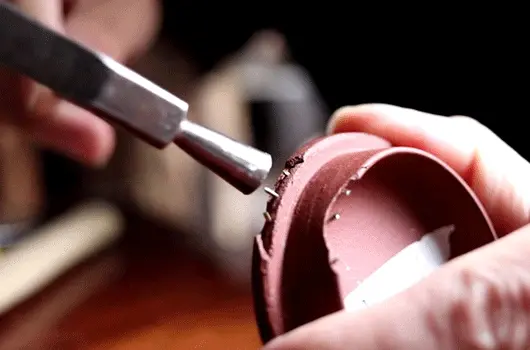
Repairing Zisha Teapot
“jinshan(golden repair)” is the second creation of a yixing zisha teapot. Our experienced repairers help you to make your broken zisha teapot reborn, even more beautiful than the original.
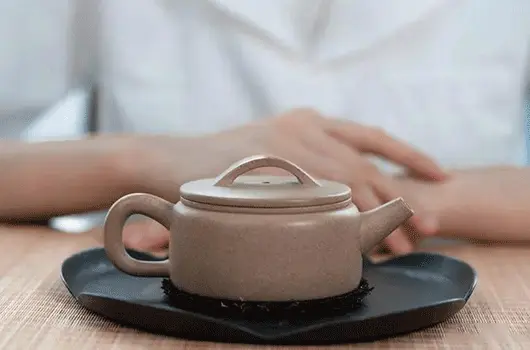
Free Identification
If you suspect that your purple clay teapot is not authentic, you can seek identification from us. We will guide you step by step to identify it.

Get In Touch
Contact us for your 1-on-1 service. We will get back to you within 24 hours.
